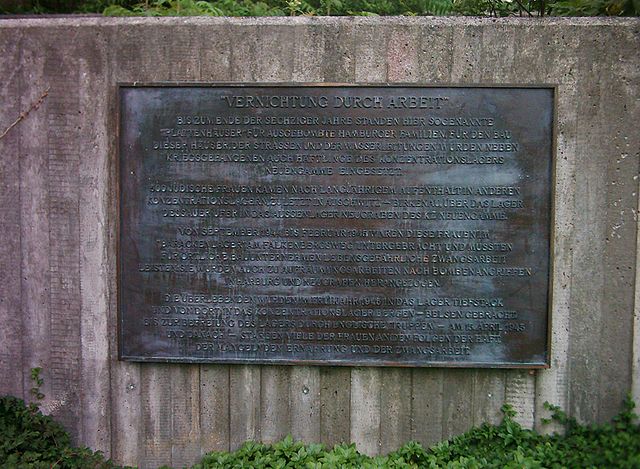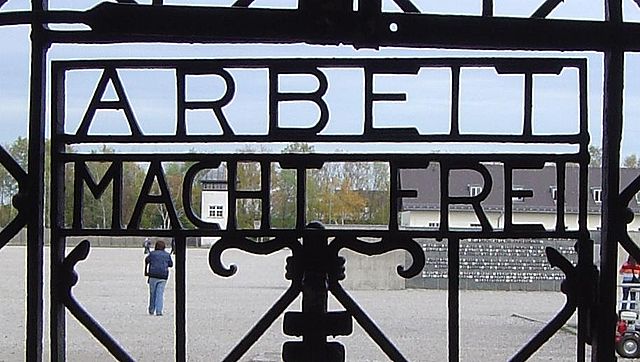killing prisoners by means of forced labour From Wikipedia, the free encyclopedia
Extermination through labour is a way of torturing and killing prisoners. In a system of extermination by labour, prisoners are forced to do very heavy work without enough food or medical care. Eventually, prisoners die from malnutrition, illness, or injury.


Nazi Germany and the Soviet Union both had systems of extermination through labor. Some people describe North Korea's prison system as a system of extermination through labor.
The term "extermination through labor" was first used during World War II. Most of the Nazi SS did not use the term (Vernichtung durch Arbeit in German). However, Albert Bormann, Joseph Goebels, Otto Georg Thierack, and Heinrich Himmler used the term during the fall of 1942, while talking about moving prisoners to concentration camps. Thierack and Goebbels specifically used the term.[1] The phrase was used again during the Nuremberg Trials after World War II ended.[1]
In the 1980s and 1990s, historians have argued over whether this term is appropriate. For example, Falk Pingel believed the phrase should not be applied to all Nazi prisoners. On the other hand, Hermann Kaienburg and Miroslav Kárný believed "extermination through labour" was one of the SS's specific goals. More recently, Jens-Christian Wagner has also argued that not all Nazi prisoners were targeted with death, so "extermination through labor" might not be the best way to describe the Nazis' goals for those prisoners.[1]
During the Holocaust, the Nazis, led by Adolf Hitler, persecuted, tortured, and killed millions of people because of differences in race, ethnicity, politics, religion, sexual orientation, and disability.[2][3]
The Nazis also persecuted people who were "German-blooded," but who the Nazis thought of as "social misfits" (aisoziale). The Nazis said these people led useless "ballast-lives" (Ballastexiltenzen). These people included:
The Nazis lists of these people and persecuted them in many ways. For example, some were forced to be sterilized. Many were eventually sent to prison camps for "extermination through labor." Along with them, anyone who spoke out against the Nazi regime (like communists, social democrats, democrats, and conscientious objectors) were sent to prison camps. Many of them did not survive.[2]
Extermination through labor was an important part of the Nazis' Final Solution - their plan to kill all the Jews in Europe.[4]

In the Nazi prison camps, prisoners were treated like slaves:[2]
Workers were also tortured and physically abused. For example, victims of Torstehen ("Gate Hanging") had to stand outside naked with their arms raised – like a gate hanging on its hinges. When they collapsed or passed out, they would be beaten until they re-assumed the position. Victims of Pfahlhängen ("Post Attachment") were tied with their hands behind their back and were hung by their hands on a tall stake. This would dislocate the prisoner's arm joints, and the pressure would be kill them within hours.

During the Holocaust, the Nazis built concentration camps and then extermination camps to imprison their victims. These "camps" were not just prisons. Their goal was not just to keep people locked up. Their goal was to torture and destroy people. All parts of camp life came along with humiliation and harassment. Forced labour was a part of this. Prisoners were whipped and treated like animals. Some forced labor was meant to help the German war machine grow. However, other prisoners were forced to do pointless heavy labor just to wear them down.[2] There were "no limits to working hours," according to official Nazi policy.[5]
A slave worker on a work assignment usually lived less than four months, on average. Up to 25,000 of the 35,000 prisoners forced to work for IG Farben at Auschwitz concentration camp died.[6][7] Some died from exhaustion or disease. Others were killed after the Nazis decided they were not healthy enough to work any more.
Some work assignments were deadlier than others. Some prisoners were assigned to dig tunnels for German weapons factories during the last months of the war. About 30% of them died.[8] In the satellite camps, which were near mines and industrial firms, death rates were even higher. In these satellite camps, the supplies were often even less adequate than in the main camps.
The phrase "Arbeit macht frei" ("work shall set you free") appeared on the entry gates at Auschwitz and other Nazi labor camps.
Some historians call the Soviet Gulag a system of death camps,[9][10][11][12] particularly in post-Communist Eastern European politics.[13] Other historians argue that this trivializes the Holocaust (makes the Holocaust seems like it was not so bad) because, at least after the war ended, a very large majority of people who entered the Gulag left alive.[14]
Alexander Solzhenitsyn introduced the expression camps of extermination by labour in his non-fiction work The Gulag Archipelago.[15] In the book, Solzhenitsyn argues that the Soviet Union beat its enemies by making them work as prisoners on big state-run projects (like the White Sea-Baltic Canal, quarries, remote railroads, and urban development projects) under terrible conditions. Roy Medvedev comments: "The penal system in the Kolyma and in the camps in the north was deliberately designed for the extermination of people."[12] Alexander Nikolaevich Yakovlev writes that Stalin was the "architect of the gulag system for totally destroying human life."[16]
According to formerly secret internal Gulag documents, some 1.6 million people must have died in the period between 1935 and 1956 in Soviet forced labour camps and colonies. This does not include people who died in prisoner-of-war camps. Most (about 900,000) of these deaths fell between 1941 and 1945.[17] At that time, World War II was ongoing, and food supplies were low in the entire country.
Russian historian Oleg Khlevniuk writes that about 500,000 people died in the camps and colonies from 1930 to 1941.[18] However, these figures do not include people who died in transport (on their way to the camps).[19] It also does not include the number of people who died shortly after their release due to the harsh treatment in the camps[20] (there were many of these people, according to both archives and memoirs).[21]
Historian J. Otto Pohl estimates that 2,749,163 prisoners died in the labour camps, colonies, and special settlements. He says this figure is incomplete.[22]
In 2010, Stanford historian Norman Naimark wrote a book called Stalin's Genocides. Naimark said scholars should change the word genocide so that it also meant killing people because they were in a social class or had political beliefs so that Stalin's killings would count as genocide.[23]
It is believed that similar camps are operating in North Korea, and killed at least 20,000 political prisoners in 2013 alone, with at least 130,000 held therein.[24][25]
Seamless Wikipedia browsing. On steroids.
Every time you click a link to Wikipedia, Wiktionary or Wikiquote in your browser's search results, it will show the modern Wikiwand interface.
Wikiwand extension is a five stars, simple, with minimum permission required to keep your browsing private, safe and transparent.